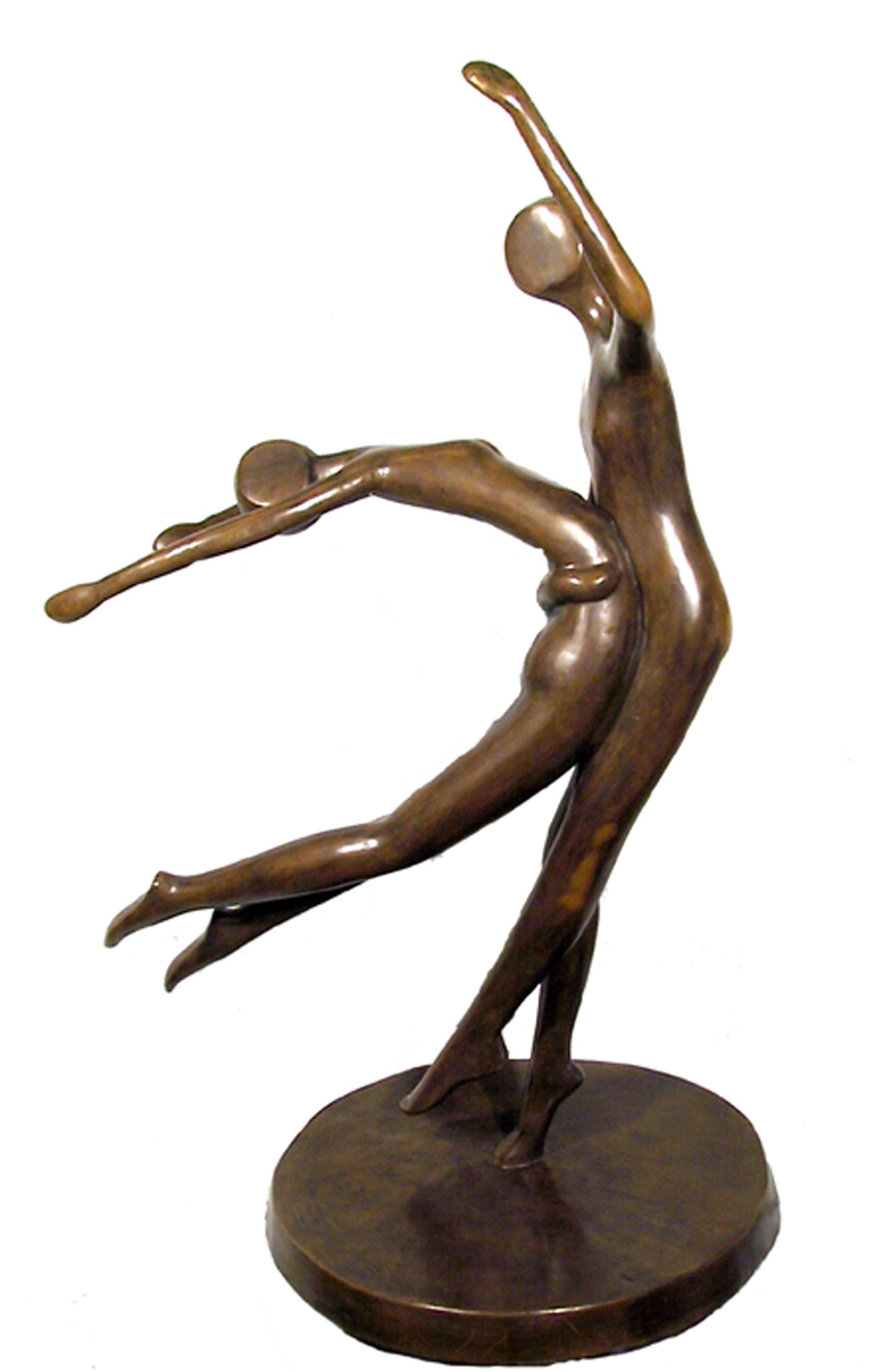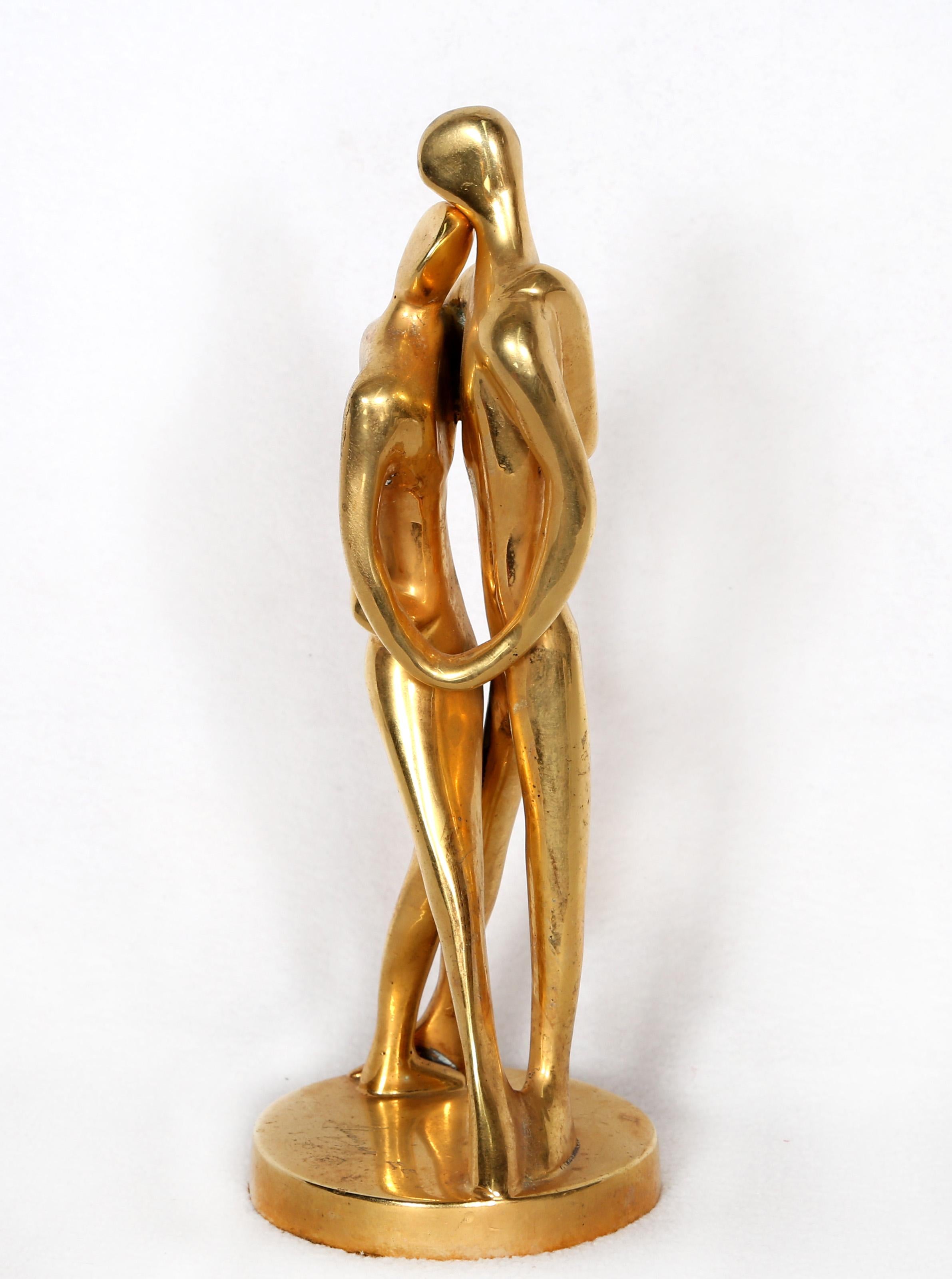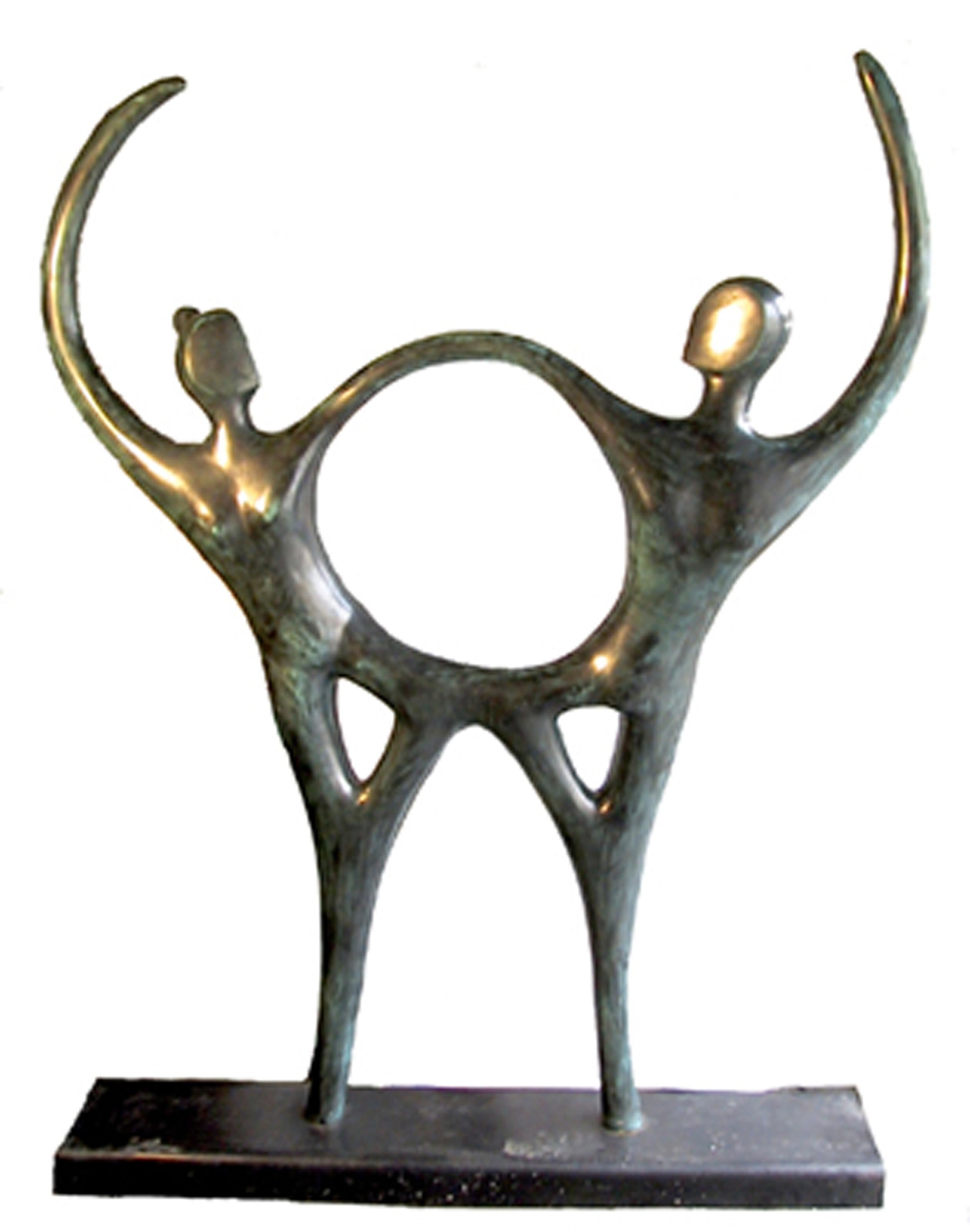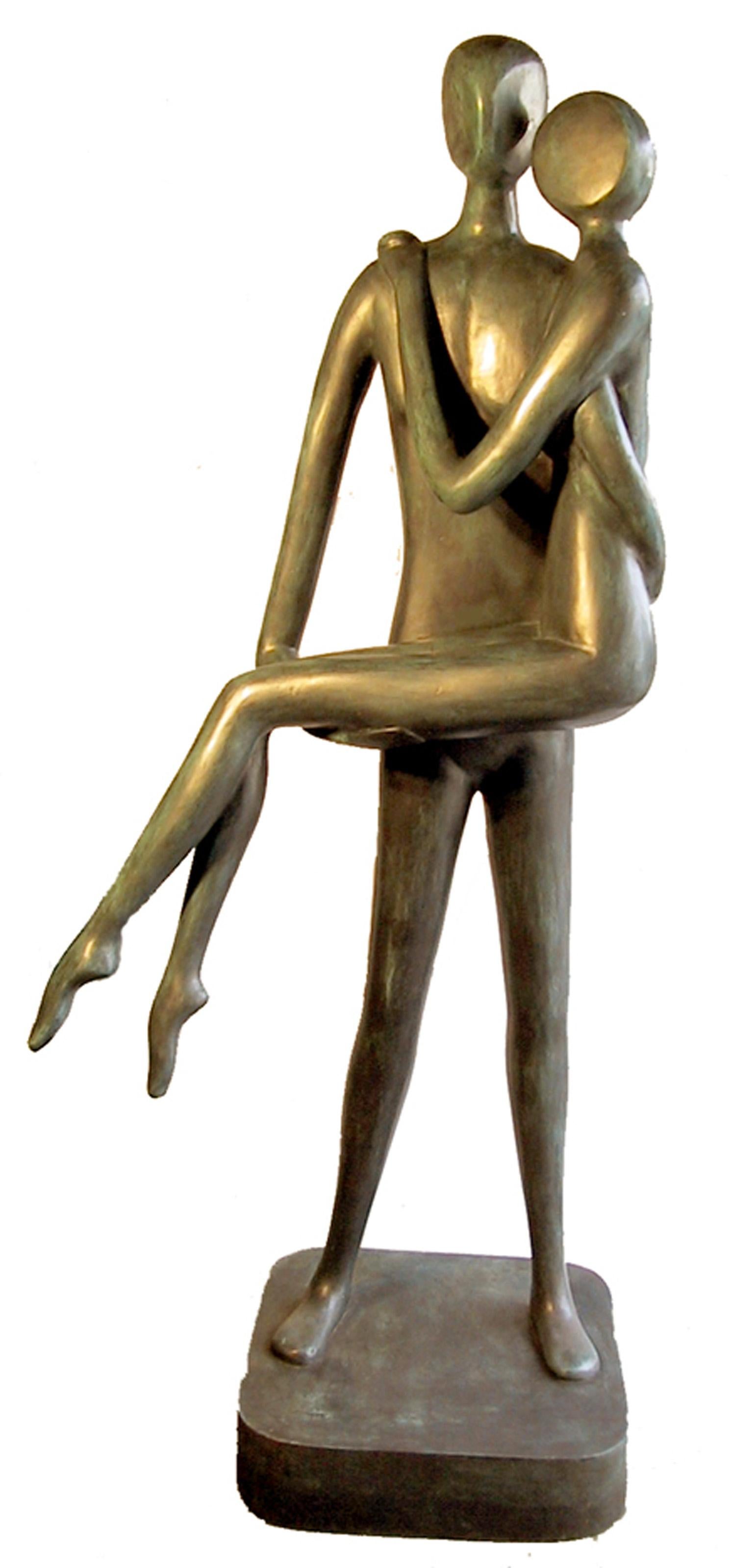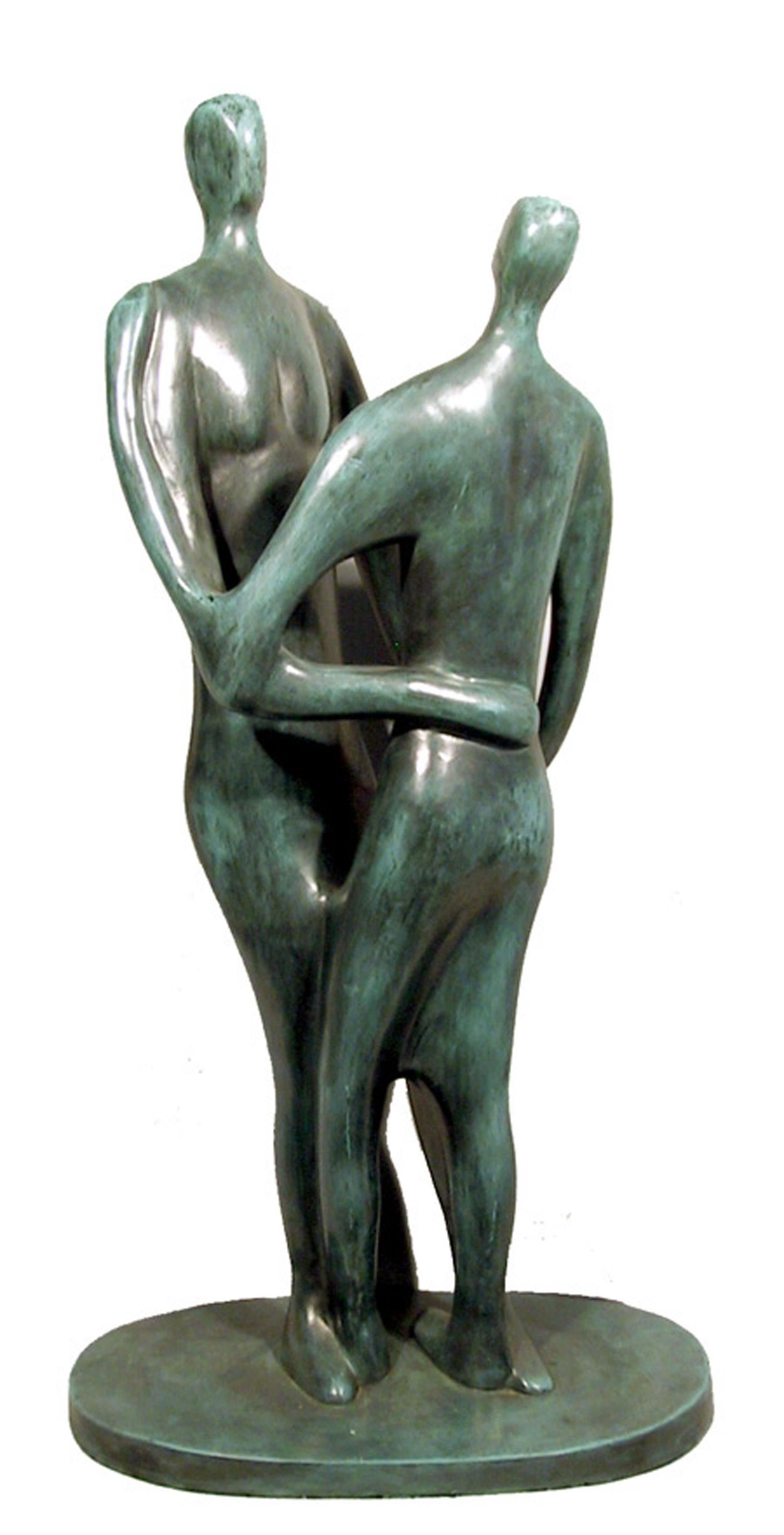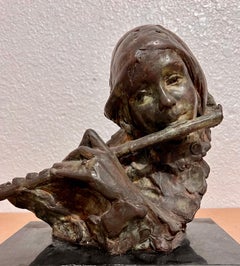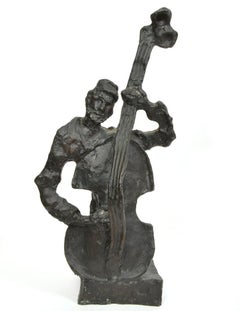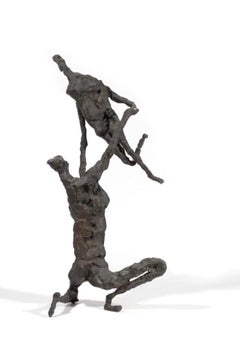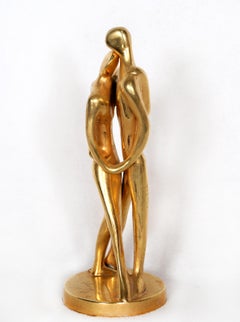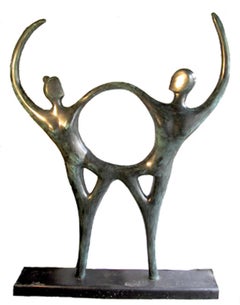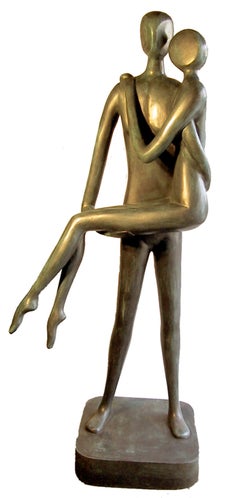Items Similar to Small Bronze Sculpture Cast Head After Rodin "Petite tete au nez retrousse"
Want more images or videos?
Request additional images or videos from the seller
1 of 15
Small Bronze Sculpture Cast Head After Rodin "Petite tete au nez retrousse"
About the Item
(after) Auguste Rodin
Posthumous cast
"Petite tete au nez retroussé"
Featuring a bust of a woman.
Limited edition bronze is mounted on a marble base and is signed on the lower right. Great detail.
Dimensions: approx. 7-1/4" tall x 5" across x 5" deep with base
Foundry mark on the reverse, #13 of 299 produced.
François Auguste René Rodin (1840 – 1917) was a French sculptor generally considered the founder of modern sculpture. Rodin possessed a unique ability to model a complex, turbulent, and deeply pocketed surface in clay. He is known for such sculptures as The Thinker, Monument to Balzac, The Kiss, The Burghers of Calais, and The Gates of Hell. He modeled the human body with naturalism, and his sculptures celebrate individual character and physicality. Although Rodin was sensitive to the controversy surrounding his work, he refused to change his style, and his continued output brought increasing favor from the government and the artistic community.
Rodin became the preeminent French sculptor of his time. By 1900, he was a world-renowned artist. Wealthy private clients sought Rodin's work after his World's Fair exhibit, and he kept company with a variety of high-profile intellectuals and artists. His student, Camille Claudel, became his associate, lover, and creative rival. Rodin's other students included Antoine Bourdelle, Constantin Brancusi, and Charles Despiau.
Rodin entered the studio of Albert-Ernest Carrier-Belleuse, a successful mass producer of objets d'art. Rodin worked as Carrier-Belleuse' chief assistant until 1870, designing roof decorations and staircase and doorway embellishments. With the arrival of the Franco-Prussian War, Rodin was called to serve in the French National Guard, but his service was brief due to his near-sightedness. Rodin took classes with animal sculptor Antoine-Louis Barye. The teacher's attention to detail and his finely rendered musculature of animals in motion significantly influenced Rodin. Rodin won the 1880 commission to create a portal for a planned museum of decorative arts. Rodin dedicated much of the next four decades to his elaborate Gates of Hell, an unfinished portal for a museum that was never built. Many of the portal's figures became sculptures in themselves, including Rodin's most famous, The Thinker and The Kiss. With the museum commission came a free studio, granting Rodin a new level of artistic freedom.
By 1900, Rodin's artistic reputation was established. Gaining exposure from a pavilion of his artwork set up near the 1900 World's Fair (Exposition Universelle) in Paris, he received requests to make busts of prominent people internationally, As Rodin's fame grew, he attracted many followers, including the German poet Rainer Maria Rilke, and authors Octave Mirbeau, Joris-Karl Huysmans, and Oscar Wilde.
Rodin and Beuret's modest country estate in Meudon, purchased in 1897, was a host to such guests as King Edward, dancer Isadora Duncan, and harpsichordist Wanda Landowska. He left Beuret in Meudon and began an affair with the American-born Duchesse de Choiseul. From 1910, he mentored the Russian sculptor, Moissey Kogan.
During his later creative years, Rodin's work turned increasingly toward the female form, and themes of more overt masculinity and femininity. He concentrated on small dance studies, and produced numerous erotic drawings, sketched in a loose way, without taking his pencil from the paper or his eyes from the model. Rodin met American dancer Isadora Duncan in 1900, attempted to seduce her, and the next year sketched studies of her and her students.
Rodin willed to the French state his studio and the right to make casts from his plasters. Because he encouraged the edition of his sculpted work, Rodin's sculptures are represented in many public and private collections. The Musée Rodin was founded in 1916 and opened in 1919 at the Hôtel Biron, where Rodin had lived, and it holds the largest Rodin collection, with more than 6,000 sculptures and 7,000 works on paper. The French order Légion d'honneur made him a Commander, and he received an honorary doctorate from the University of Oxford.
During his lifetime, Rodin was compared to Michelangelo, and was widely recognized as the greatest artist of the era. Rodin had enormous artistic influence. A whole generation of sculptors studied in his workshop. These include Gutzon Borglum, Antoine Bourdelle, Constantin Brâncuși, Camille Claudel, Charles Despiau, Malvina Hoffman, Carl Milles, François Pompon, Rodo, Gustav Vigeland, Clara Westhoff and Margaret Winser, Rodin also promoted the work of other sculptors, including Aristide Maillol and Ivan Meštrović whom Rodin once called "the greatest phenomenon amongst sculptors." Other sculptors whose work has been described as owing to Rodin include Joseph Csaky, Alexander Archipenko, Joseph Bernard, Henri Gaudier-Brzeska, Georg Kolbe, Wilhelm Lehmbruck, Jacques Lipchitz, Pablo Picasso, Adolfo Wildt, and Ossip Zadkine. Henry Moore acknowledged Rodin's seminal influence on his work. Several films have been made featuring Rodin as a prominent character or presence. These include Camille Claudel, a 1988 film in which Gérard Depardieu portrays Rodin, Camille Claudel 1915 from 2013, and Rodin, a 2017 film starring Vincent Lindon as Rodin. Furthermore, the Rodin Studios artists' cooperative housing in New York City, completed in 1917 to designs by Cass Gilbert, was named after Rodin.
- Dimensions:Height: 7.25 in (18.42 cm)Width: 5 in (12.7 cm)Depth: 5 in (12.7 cm)
- Medium:
- Movement & Style:
- After:Auguste Rodin (1840 - 1917, French)
- Period:
- Condition:
- Gallery Location:Surfside, FL
- Reference Number:1stDibs: LU38213962742
About the Seller
4.9
Platinum Seller
Premium sellers with a 4.7+ rating and 24-hour response times
Established in 1995
1stDibs seller since 2014
1,744 sales on 1stDibs
Typical response time: 2 hours
- ShippingRetrieving quote...Shipping from: Surfside, FL
- Return Policy
Authenticity Guarantee
In the unlikely event there’s an issue with an item’s authenticity, contact us within 1 year for a full refund. DetailsMoney-Back Guarantee
If your item is not as described, is damaged in transit, or does not arrive, contact us within 7 days for a full refund. Details24-Hour Cancellation
You have a 24-hour grace period in which to reconsider your purchase, with no questions asked.Vetted Professional Sellers
Our world-class sellers must adhere to strict standards for service and quality, maintaining the integrity of our listings.Price-Match Guarantee
If you find that a seller listed the same item for a lower price elsewhere, we’ll match it.Trusted Global Delivery
Our best-in-class carrier network provides specialized shipping options worldwide, including custom delivery.More From This Seller
View AllPolish Modernist Charging Rhino Bronze Expressionist Rhinoceros Sculpture
By Dominik Albinski
Located in Surfside, FL
Signed bronze from small edition of 8. plus 4 artists proofs
Dominik Albiński
(born 1975, South Africa)
He started carving at the age of twelve. When he was eighteen he went to Pari...
Category
Early 2000s Modern Figurative Sculptures
Materials
Granite, Bronze
Bronze Sculpture Flutist American Modernist Art Stanley Bleifeld Girl with Flute
By Stanley Bleifeld
Located in Surfside, FL
Retaining a fine patina and in overall good condition.
Signed with initials SB.
I believe the edition size was 7 But I cannot find a mark.
Stanley Bleifeld (1924 – 2011) was an American sculptor.
Stanley Bleifeld was born and raised in Brooklyn, New York, Bleifeld earned bachelor of fine arts, bachelor of science in education and in 1949 a master of fine arts degree in painting at Tyler School of Art of Temple University. After a trip to Rome in 1959 or 1960 he gave up painting for sculpture. He began his fine-art career as a painter. However, a visit to Italy and exposure to the bronzes of Donatello, Michelangelo, and Ghiberti changed his direction He worked with the Art Foundry of Massimo del Chiaro and alongside artists such as Lucchesi, Harry Marinsky, Fernando Botero, Igor Mitoraj and Ivan Theimer. Many of his early pieces were religious subjects, and reflected both painting and sculptural techniques in bas reliefs* that had "liquid landscapes in undulating reliefs and free-flowing portraits reminiscent of classical fragments" (166-167). He later turned from these abstract pieces to more realistic figures in bronze.
Bleifeld was a National Academician in Sculpture, and a member of the National Academy of Design, and helped set policy for that organization. He was also President of the National Sculpture Society. Past presidents of the society have included John Quincy Adams Ward, James Earle Fraser, Chester Beach, Wheeler Williams, Leo Friedlander, Neil Estern, and Cecil de Blaquiere Howard. The first woman to gain admission into the NSS was Theo Alice Ruggles Kitson, in 1893. She was followed a few years later by Enid Yandell and Bessie Potter Vonnoh in 1898; Janet Scudder in 1904; Anna Hyatt Huntington in 1905 and Evelyn Longman and Abastenia St. Leger Eberle in 1906. In 1946, Richmond Barthé was likely the first African-American to be admitted.
In 1994, the NSS held their first exhibition outside the United States at the Palazzo Mediceo Di Seravezza in Italy. Titled “100 Years of the National Sculpture Society of the United States of America in Italy” it ran from the 16th of July through the 4th of September and was curated by Nicky and Stanley Bleifeld along with Costantino Paolicchi, Lodovico Gierut and Paolo Giorgi. Among the 60 notable American sculptors whose work was selected for the exhibition were Stanley Bleifeld, Andrew DeVries, Neil Estern, Leonda Finke, Bruno Lucchesi, Barbara Lekberg...
Category
1970s American Modern Figurative Sculptures
Materials
Bronze
Russian French Judaica Jewish Shtetl Wedding Klezmer Musician Bronze Sculpture
By Mane Katz
Located in Surfside, FL
Bronze Double Bass Player Klezmer Musician Sculpture signed Mane-Katz at base. Numbered 8/8.
-Katz (1894-1962) was a Litvak painter born in Ukraine best known for his depictions of...
Category
1960s Modern Figurative Sculptures
Materials
Bronze
Large Bronze Modernist Sculpture Acrobats 1/3 French German Artist Gerard Koch
Located in Surfside, FL
Untitled (it depicts acrobats, trapeze artists or gymnasts in mid pose)
bronze cast sculpture
signed and numbered from small edition (1 of 3).
Gerard Koch was a French Post War & C...
Category
20th Century Modern Figurative Sculptures
Materials
Bronze
Chaim Gross Mid Century Mod Bronze Sculpture Balancing WPA Artist Mom and Child
By Chaim Gross
Located in Surfside, FL
Chaim Gross (American, 1904-1991)
Patinated cast bronze sculpture,
Balancing, Mother and child
signed and editioned 1/6
mounted on black marble plinth
14"h x 11.5"w x 8"d (height w...
Category
1960s American Modern Figurative Sculptures
Materials
Bronze
Sydney Kumalo Bronze Minimalist African Modernist Sculpture Figural Female Nude
Located in Surfside, FL
Sydney Kumalo. Features a bronze stylized female figural form sculpture fixed to a marble plinth and wood base. Bears signature on base. Measures 9 1/2" x 4 1/4". There is no edition number on the piece.
Sydney Kumalo (1935 - 1988) was born in Sophiatown, Johannesburg, on 13 April 1935. His was one of the families who had to move out of the "white" city to the South Western Townships, or Soweto. Raised in Diepkloof and educated at Madibane High School, he took with him from old Sophiatown the curious and diverse heritage of its heyday. Art classes in the Catholic school, "Sof' town" blues and jazz, the vibrant street culture and growing defiance of its population of various races who were gradually forced out into separate race-group areas. So it was that these various aspects of his early life created for Kumalo a cultural mix of a Zulu family related to the traditional royal house; city schooling, nascent township music and lingo; growing urbanised political defiance and the deep-rooted Zulu pride and respect for the legends and ancient stories of a tribal people. This mix of old and new cultures was reinforced when he began his studies at the Polly Street Art Centre in 1953 where he became a member of Cecil Skotnes group of serious artists who were encouraged to acquire professional skills. Skotnes introduced a basic training programme with modelling as a component, which marked the introduction of sculpting (in brick-clay) at Polly Street.
Kumalo was Skotnes’ assistant at Polly Street from 1957 to 1964, and having recognised his great talent as a sculptor, Skotnes encouraged him to become a professional artist.
After Kumalo’s very successful assistance with a commission to decorate the St Peter Claver church at Seeisoville near Kroonstad, with painting designs, sculpture and relief panels in 1957, Skotnes arranged for Kumalo to continue his art training by working in Edoardo Villa ’s studio from 1958 to 1960. Working with Villa, he received professional guidance and began to familiarize himself with the technical aspects of sculpting and bronze casting. In 1960 he became an instructor at the Polly Street Art Centre.
Kumalo started exhibiting his work with some of the leading commercial Johannesburg galleries in 1958, and had his first solo exhibition with the Egon Guenther Gallery in 1962. He was a leader of the generation who managed to leave behind the forms of African curios, reject the European-held paternalism which encouraged notions of "naive" and "tribal" African art, and yet still hold fast to the core of the old legends and spiritual values of his people. He introduced these subjects into his bronze sculptures and pastel drawings, evolving his own expressive, contemporary African "style".
Together with Skotnes, Villa, Cecily Sash and Giuseppe Cattaneo, Kumalo became part of the Amadlozi group in 1963. This was a group of artists promoted by the African art collector and gallery director Egon Guenther, and characterised by their exploration of an African idiom in their art. Elza Miles writes that Cecil Skotnes’ friendship with Egon Guenther had a seminal influence on the aspirant artists of Polly Street: “Guenther broadened their experience by introducing them to German Expressionism as well as the sculptural traditions of West and Central Africa. He familiarised them with the work of Ernst Barlach, Käthe Kollwitz, Gustav Seitz, Willi Baumeister and Rudolf Sharf.” It is therefore not surprising that some of Kumalo’s sculptures show an affinity with Barlach’s powerful expressionist works. Guenther organised for the Amadlozi group to hold exhibitions around Italy, in Rome, Venice, Milan and Florence, in both 1963 and 1964.
Kumalo’s career took off in the mid 1960s, with his regular participation in exhibitions in Johannesburg, London, New York and Europe. He also represented South Africa at the Venice Biennale in 1966, and in 1967 participated in the São Paulo Biennale.
EJ De Jager (1992) describes Kumalo’s sculpture as retaining much of the “canon and formal aesthetic qualities of classical African sculpture. His work contains the same monumentality and simplicity of form.” His main medium for modelling was terra cotta, which was then cast in bronze, always paying careful attention to the finish of both the model as well as the final cast. He began casting the pieces he modelled in clay or plaster into bronze at the Renzo Vignali Artistic Foundry in Pretoria North. He worked throughout his life with its owners, the Gamberini family, and enjoyed learning the technical aspects of the casting process, refining his surfaces according to what he learned would produce the best results in metal. De Jager further writes that Kumalo’s distinctive texturing of the bronze or terra cotta is reminiscent of traditional carving techniques of various African cultures. “In many respects Kumalo thus innovated a genuine contemporary or modern indigenous South African sculpture”. Kumalo came to admire the works of the Cubists, and of British sculptors Henry Moore and Lynn Chadwick. He became noted for adapting shapes from them into his own figures. The success of his use of the then current monumental simplicity and purely aesthetic abstractions of natural forms has been emulated by many South African sculptors since the 1970s.
He was in many ways the doyen of South African Black art. As such he was an important influence especially on younger African sculptors, by whom he is greatly revered. Through his teaching at Polly Street and at the Jubilee Centre, as well as through his personal example of integrity, dedication and ability, he inspired and guided students who in their own right became outstanding artists, for example, Ezrom Legae, Leonard Matsoso and Louis Maqhubela
From 1969 onward, he allied himself with Linda Givon, founder of The Goodman Gallery in Johannesburg, where he exhibited regularly until his death in December 1988. Working with Givon also perpetuated his associations with his many friends of strong principles. Skotnes, Villa, Legae and later such peers from the Polly Street era as Leonard Matsoso, Durant Sihlali and David Koloane have all exhibited at The Goodman Gallery. Kumalo, Legae, and later Fikile (Magadlela) and Dumile (Feni) were among the leading exponents of a new Afrocentric art...
Category
20th Century Modern Figurative Sculptures
Materials
Marble, Bronze
You May Also Like
Danza de Amor, Modern Bronze Sculpture by Jose Almanzor
Located in Long Island City, NY
Danza de Amor
Jose Almanzor, Mexican (1962–2015)
Date: circa 1990
Bronze Sculpture, Signature and number inscribed
Edition of XXX
Size: 40 x 28 x 20 in. ...
Category
1990s Modern Figurative Sculptures
Materials
Bronze
Tango, Modern Bronze Sculpture with Gold Patina by Jose Almanzor
Located in Long Island City, NY
Tango
Jose Almanzor, Mexican (1962–2015)
Date: circa 1990
Bronze Sculpture with gold patina, signature and numbering inscribed
Edition of 1/75
Size: 9.75...
Category
1990s Modern Figurative Sculptures
Materials
Bronze
Bailarines, Modern Bronze Sculpture by Jose Almanzor
Located in Long Island City, NY
Bailarines
Jose Almanzor, Mexican (1962–2015)
Date: circa 1990
Bronze Sculpture
Size: 67 x 50 x 10 in. (170.18 x 127 x 25.4 cm)
Category
1990s Modern Figurative Sculptures
Materials
Bronze
Noche de Bodas, Modern Bronze Sculpture by Jose Almanzor
Located in Long Island City, NY
Noche de Bodas
Jose Almanzor, Mexican (1962–2015)
Date: circa 1990
Bronze Sculpture, signature and number inscribed
Edition of I/XXX
Size: 60 x 24.5 x 12...
Category
1990s Modern Figurative Sculptures
Materials
Bronze
Tango, Modern Bronze Sculpture by Jose Almanzor
Located in Long Island City, NY
Tango
Jose Almanzor, Mexican (1962–2015)
Date: circa 1990
Bronze Sculpture, signature and numbering inscribed
Edition of I/L
Size: 32.25 x 16 x 8.5 in. (...
Category
1990s Modern Figurative Sculptures
Materials
Bronze
Chief Joseph of the Nez Perce Indians, Bronze Sculpture by Arnold Goldstein
Located in Long Island City, NY
Chief Joseph of the Nez Perce Indians by Arnold Goldstein, American
Date: 1975
Bronze, signed, inscribed and numbered
Edition of 4/30
Size: 18 in. x 13 in. x 9 in. (45.72 cm x 33.02 ...
Category
1970s American Modern Figurative Sculptures
Materials
Bronze
Recently Viewed
View AllMore Ways To Browse
Small Sculpture Vintage
Small French Sculpture
Bronze Head Sculptures
Small Head Sculpture
Small Marble Sculpture
Cast Bronze Marble Sculpture
Brancusi Sculpture
Marble Sculpture Head
Cast Plaster Sculpture
Plaster Art Casts
Head Of A Woman Sculpture
World Fair Exposition
Bronze Cast Body Sculpture
Female Head Sculpture
Sculpture Guard
Bronze Sculpture 1910
Plaster Head Sculpture
5 Tall Sculpture
